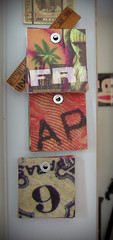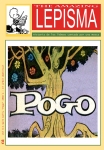It happens all the time. A client, maybe an old one, maybe a new prospect calls with what, at first glance, appears to be a totally lame or mundane project. Most designers roll their eyes, dish it off to an intern or even worse, crank out a ho-hum solution. Sound familiar? But, what if...
What if, instead of dismissing the project as a no-brainer, you actually put some brainpower into it. What if you approached the project as something that you yourself would actually pick up and read. What if you could turn this predictable, boring nothing into something cool, fun, interesting and possibly great or even collectible. What if you got off your ass, stepped away from the computer and took the tried and true old school approach. That' right, the paper and pencil approach. To me, a blank computer screen is intimidating. Sure, you can easily set up a document, pick a nice font, throw in a picture and call it done, but then what? Any No Talent Ass Clown can do that - just look at all the people calling themselves designers simply because they have a computer. Where's the concept? Where's the idea? Where's the beef?
The computer can be a great tool to enhance any idea but the idea needs to come first. And ideas are funny things - they don't work unless you do. Starting any project in front of your computer is the first step to joining the masses of the NTAC. It's lazy, it's predictable and the results are about as interesting as made for TV movie. What if you started a project with an idea, your brain, a pencil and a blank piece of paper? You know, the work part. And yes, the hard part. Ideas building upon ideas until you arrive upon something that truly works. Most successful projects and ventures start this way so it's really no mystery as to why some things work and others just, well, suck. There's really no better way to approach a project or task, old or new, and the results are almost always worth the effort of actually doing it right. Who knows, you might even exceeded both the client's expectations and yours as well! Even if your big idea gets shot down, at least you'll be stretching your creativity muscles and perhaps one step closer to discovering a gem of a project for future use - either way, it's never wasted time. It's all in how you approach it. Lowly production job, or meaningful project? Half empty or half full. It's your monkey.
HMK
In Ron Suskind's best-seller The Price of Loyalty, Paul O'Neill recounts his first meeting as U.S. Treasury Secretary with President George W. Bush. As their conversation progresses, O'Neill is confounded by the President's obvious lack of engagement.
Late in the meeting, O'Neill says, "All right, Mr. President, maybe to finish up we could talk about global climate change ...." O'Neill had provided a booklet titled "Science, Politics & Global Climate Change" to prep the President for this discussion. "... O'Neill had sent over a booklet Alcoa had produced in 1998 with the text of an extensive speech he had given—a thorough analysis of the issue .... Bush seemed to indicate with a tilt of the head that he had read it. But, again, O'Neill wasn't certain."
I felt a rush of surprise reading this—not to learn that G.W. wasn't on the ball, but to realize that I had designed the booklet that the President of the United States had ignored.
Well, heck! That's cool. But there's a more interesting story to "Science, Politics & Global Climate Change"—and a good design lesson, too.
The job didn't start out as anything like a design project. My longtime Alcoa client called to say that O'Neill, then Alcoa's chairman, had given an important speech on one of his most passionate interests: global climate change. O'Neill wanted the speech printed and distributed. Could I set the text in a nice typeface?
This was truly more a skilled production job than a design project. A few days later, I delivered what was requested: nice type, nice paper, 8 1/2 x11in. But I also prepared an alternative: a small, 32-page book with an illustrated cover. I was betting there might be a difference between what my client requested and what O'Neill really wanted.
What did O'Neill say he wanted? A speech reprint. But what did he actually want? He wanted the print equivalent of his speech: an eloquent, compelling call to action on an urgent issue, meant to engage the mind, expand the reader's understanding and inspire change.
I proposed a chunky, 6x7in., perfect-bound mini-book with a cover illustration by Rob Day. O'Neill's words, so energetic in person, received equal impact in print through bold typography, bright subheads and readable layouts. A business guru once said, "Satisfy the unexpressed wish." "Science, Politics & Global Climate Change" satisfied O'Neill's unexpressed wish. Hearing what the client really wanted created a design project for me—when before there was none.
I've had other experiences in creating a project from nothing, frequently enough to have formed a few conclusions. First: Don't think about the money. Not your fees, not the budget, not the print costs. If the solution answers the need in a way that delights and surprises, the money often works out.
Second: Be sure to also present a solution that responds to the client's request. If you disregard what he specified, your client might take offense. Do what is requested and do what it ought to be.
Third: Don't presume your brilliant solution will be accepted. If it never gets out of the gate, your client will appreciate the extra effort nonetheless. And finally: Cultivate a mindset that constantly goes beyond the client's stated needs. Listen carefully and critically, and dream on your client's behalf. Satisfy the unexpressed wish.
Thanks to Rick Landesberg
Subscribe to:
Post Comments (Atom)





























































No comments:
Post a Comment